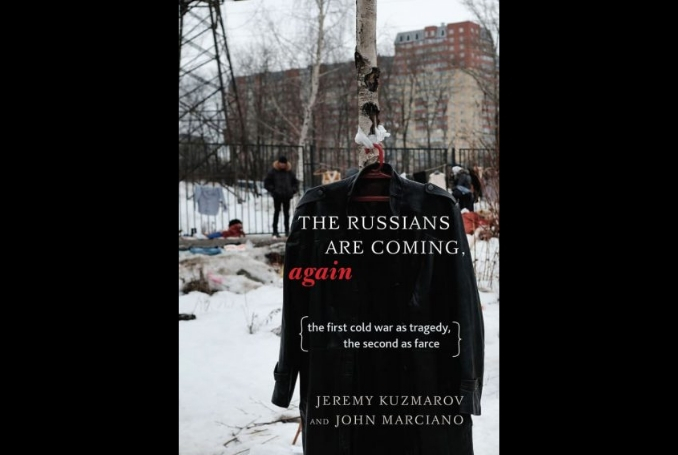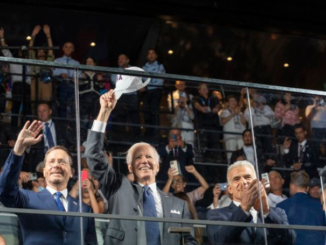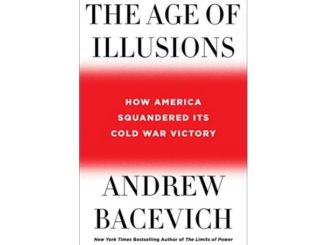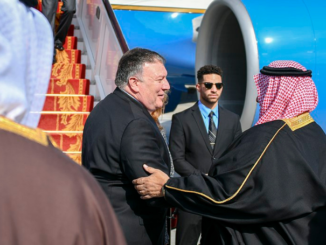
By Jim Miles
(The Russians are Coming, Again – The First Cold War as Tragedy, the Second as Farce. Jeremy Kuzmarov and John Marciano. Monthly Review Press, New York, 2018.)
The mainstream media continues to harvest all the disinformation it can concerning the relationship between Trump and Putin and the character of Putin himself, not to mention the overall generalizations about the state of Russia and the kind of people Russians are. Jeremy Kuzmarov and John Marciano argue in The Russians are Coming, Again – The First Cold War as Tragedy, the Second as Farce that Russia bashing is nothing new, extends back to before the First World War, and is for the most part wrong.
There is much material compacted into this short work comparing the first Cold War to the events of the new Second Cold War. The argument, however, begins back during the First World War when the Bolshevik revolution overturned the Russian monarchy to establish a country ruled by the proletariat rather than royalty, businessmen, and bankers. Fearing the loss of the markets and resources available in Russia, the U.S. along with many other WWI allies invaded Russian territory, most notably in the southwest and in Siberia.
One of the participants said,
“The American war with Russia had no idealism. It was not a war at all. It was a freebooter’s excursion, depraved and lawless. A felonious undertaking for it had not the sanction of the American people.”
In other words, well before Vietnam and many other overseas attacks on former western colonial projects, well before modern concerns about Congress voting on war, the U.S. within its imperial interests had attacked Russia, with the result that “after sending troops to quell the revolution, the Soviets would never again trust the United States, predominantly for good reasons, as later history would prove.”
Although Churchill was one of the supreme promoters of the post World War II Cold War, initiating the descriptor ‘the Iron Curtain”, and always eager for a hot war, it was the U.S. that determined the course of actions leading into and through the first Cold War. For Stalin, his main goal “was to establish a security belt in eastern Europe to prevent another German invasion and to consolidate influence over Communist regimes there to help revitalize the Soviet economy which had lost much of its productive capacity.”
A CIA analyst wrote,
“The specter of a powerful Russia was remote from the reality of a country weakened by war, with a shattered economy, an overtaxed civilian and military bureaucracy and large areas of civil unrest.”
The Soviet Union did present a threat however to the U.S.’ newfound power. Many countries in Europe had elected communist representatives with some being included within the executive structures. Russia’s rapid post-war industrialization and increased economic and social productivity provided an alternative to capitalism for many new nations, former colonies of the western powers. The U.S. dogma concerned the aggressive hostile nature of the Soviet Union, its large ever-increasing military arsenal, in particular, nuclear weapons, and its “evil” nature. The Soviet state was subversive, while the U.S. was “a nation of almost unimaginable perfection” marked by “marvelous diversity….deep tolerance….and lawfulness.”
Other topics covered during this initial phase of the Cold War include the atomic bombing of Japan, the many U.S. bases already surrounding the Soviet Union, the Marshall Plan and its true purpose, and the many former Nazis used by the U.S. for weapons research including biochemical weapons and ballistic missiles. From these foreboding beginnings, Kuzmarov and Marciano travel through the history of how the U.S. misrepresented the nature of the Soviet Union’s actions, and its people and leaders.
Several themes stand out. First as indicated above was the supposed evil nature of Soviet Russia. Another obvious theme is that of the supposed “missile gap” providing the excuse for U.S. military corporations to harvest huge profits on the taxpayer’s dollar, at the same time creating a fearful taxpayer living under the threat of nuclear catastrophe and Soviet invasions.
McCarthyism and its “red scare” tactics worked wonderfully to disempower unions, socialists of any degree, the women’s movement, and curtail the growth of the freedoms desired by black Americans. Martin Luther King epitomized the latter and his assassination probably has more to do with his comments on the capitalist exploitive system in the U.S. than it did on his comments on peace and freedom.
As always U.S. corporations received protection for their overseas extraction of resources using cheap labor. All these themes have a commonality with events occurring under the current U.S. regime vis a vis “Putin’s Russia”.
The chapter “A War on the Global South: The Cold War in the Third World” takes the reader through an all too familiar litany of U.S. overt and covert military and subversive actions in nations of the Third World. The history runs through the Korean War, CIA regime change operations (Iran, Guatemala, Congo/Zaire et al), JFK and Cuba, the Indo-China wars (inclusive of Laos and Cambodia), the role of police training and torture at various U.S. military bases, and the variety of actions within “Rambo” Reagan’s Cold War.
These military scenarios are very familiar to those following current U.S. created wars in the greater Middle East, spreading through Africa, and bordering on Russia itself as NATO grew and sparked military action in Yugoslavia, Afghanistan, Libya, Georgia, Ukraine, and Syria. The latter three represent what has truly unsettled current U.S. neocons and war hawks – that Russia has managed to assist other countries and people in standing against violent attempts to spread the empire in its attempts at global hegemony – all the more reason to demonize Putin and Russia, denigrating its success, and making the necessary evil other for the warlords for both domestic control and foreign belligerence.
In their conclusions, the authors argue that “peace is possible if we change our approach” in short, to work cooperatively with Russia “to solve global problems such as climate change, terrorism, and the threat of nuclear proliferation, and…cooperate economically…to our mutual benefit.” They add a warning, well advised, “to be wary of media and political manipulation.”
It ties in with their comments about “understanding the agenda underlying the demonization of Putin, and how the media manufacture consent” and then to “learn to investigate issues, think more independently and critically,” or in short “educate ourselves.” Ultimately they propose that “our only hope remains the development of a citizen’s campaign for peace and justice along the line of the anti-Vietnam War movement.”
These are highly laudable goals and I wish them well. Unfortunately having already “educated myself” as best I can – and who knows, perhaps I am wrong – but the cynic in me says it will take more than an anti-war style movement to alter the direction of the U.S. ship of state as it continues with its foreign militaristic adventures and its domestic security repression and declining social demographics. Hopefully, the newly realized multi-polar world will be able to cool off some of the hotter heads in U.S. politics before they reach ignition.
The Russians are Coming, Again – The First Cold War as Tragedy, the Second as Farce is an interesting well-written book that summarizes and highlights the nature of U.S. views and actions towards Russia, then and now. It would serve as a good primer for those initiating their study on U.S.-Russia relations and a good summary review for those already familiar with the reality of those relations.
– Jim Miles is a Canadian educator and a regular contributor/columnist of opinion pieces and book reviews to Palestine Chronicles. His interest in this topic stems originally from an environmental perspective, which encompasses the militarization and economic subjugation of the global community and its commodification by corporate governance and by the American government.

– Jim Miles is a Canadian educator and a regular contributor/columnist of opinion pieces and book reviews to Palestine Chronicles. His interest in this topic stems originally from an environmental perspective, which encompasses the militarization and economic subjugation of the global community and its commodification by corporate governance and by the American government.








